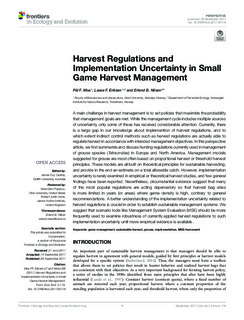| dc.contributor.author | Moa, Pål Fossland | |
| dc.contributor.author | Eriksen, Lasse Frost | |
| dc.contributor.author | Nilsen, Erlend Birkeland | |
| dc.date.accessioned | 2017-09-28T11:51:34Z | |
| dc.date.available | 2017-09-28T11:51:34Z | |
| dc.date.created | 2017-09-27T13:05:31Z | |
| dc.date.issued | 2017 | |
| dc.identifier.citation | Moa, P. F., Eriksen, L. F. & Nilsen, E. B. (2017). Harvest regulations and implementation uncertainty in small game harvest management. Frontiers in Ecology and Evolution, 5: 118. doi: | nb_NO |
| dc.identifier.issn | 2296-701X | |
| dc.identifier.uri | http://hdl.handle.net/11250/2457318 | |
| dc.description.abstract | A main challenge in harvest management is to set policies that maximize the probability that management goals are met. While the management cycle includes multiple sources of uncertainty, only some of these has received considerable attention. Currently, there is a large gap in our knowledge about implemention of harvest regulations, and to which extent indirect control methods such as harvest regulations are actually able to regulate harvest in accordance with intendedmanagement objectives. In this perspective article, we first summarize and discuss hunting regulations currently used inmanagement of grouse species (Tetraonidae) in Europe and North America. Management models suggested for grouse are most often based on proportional harvest or threshold harvest principles. These models are all built on theoretical principles for sustainable harvesting, and provide in the end an estimate on a total allowable catch. However, implementation uncertainty is rarely examined in empirical or theoretical harvest studies, and few general findings have been reported. Nevertheless, circumstantial evidence suggest that many of the most popular regulations are acting depensatory so that harvest bag sizes is more limited in years (or areas) where game density is high, contrary to general recommendations. A better understanding of the implementation uncertainty related to harvest regulations is crucial in order to establish sustainable management systems. We suggest that scenario tools like Management System Evaluation (MSE) should be more frequently used to examine robustness of currently applied harvest regulations to such implementation uncertainty until more empirical evidence is available. | nb_NO |
| dc.language.iso | eng | nb_NO |
| dc.publisher | Frontiers Media | nb_NO |
| dc.rights | Navngivelse 4.0 Internasjonal | * |
| dc.rights.uri | http://creativecommons.org/licenses/by/4.0/deed.no | * |
| dc.title | Harvest Regulations and Implementation Uncertainty in Small Game Harvest Management | nb_NO |
| dc.type | Journal article | nb_NO |
| dc.type | Peer reviewed | nb_NO |
| dc.description.version | publishedVersion | nb_NO |
| dc.rights.holder | © 2017, The Author(s) | nb_NO |
| dc.subject.nsi | VDP::Zoologiske og botaniske fag: 480 | nb_NO |
| dc.subject.nsi | VDP::Zoology and botany: 480 | nb_NO |
| dc.source.pagenumber | 7 | nb_NO |
| dc.source.volume | 5 | nb_NO |
| dc.source.journal | Frontiers in Ecology and Evolution | nb_NO |
| dc.identifier.doi | 10.3389/fevo.2017.00118 | |
| dc.identifier.cristin | 1498896 | |
| dc.relation.project | Regionale Forskningsfond Midt-Norge: 245818 | nb_NO |

